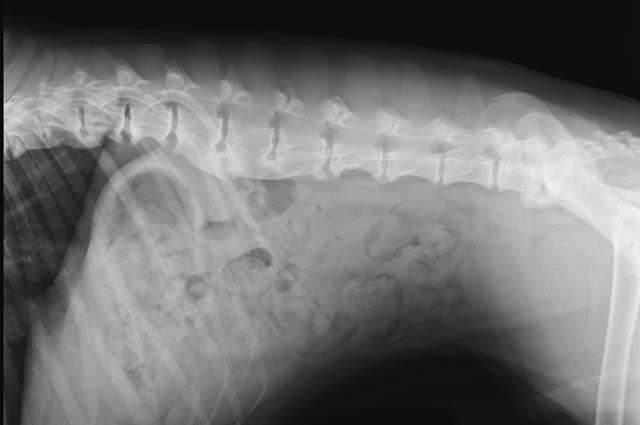What is Spondylosis? Spondylosis deformans is a term for when the body attempts to form a bony bridge over a vertebral space. It is visible on the ventral (bottom) surface of the spinal column as a solid bar linking two vertebral bodies and spanning the space between them.
Spondylosis is a very common disease in middle-aged to older dogs. It is sometimes an incidental finding on radiographs taken for a separate reason, but I usually have a suspicion of osteoarthritis or intervertebral disc disease when I see it. Many times, my patients will show sensitivity on palpation of the spine or have exhibited stiffness noted by the owners.
Research has suggested that Boxers have a genetic predisposition to spondylosis, but I see it in many types of dogs. Studies have not definitively proven a direct cause, but I usually think of the bridge formation as the body’s reaction to the presence of instability or inflammation. Instability in the spinal column is unhealthy, as the body strives for stability.

How is Spondylosis Treated in Dogs?
Most dog owners just want to know how to make their dogs comfortable. I usually try weight management because excess weight puts pressure on all the joints, the spine most of all. People ask me about exercise, and many think that their affected dog can no longer be active, but activity is always important. If your dog has spondylosis, you may want to choose lower-impact choices, like swimming and walking, over running and retrieval games.
Any dog exhibiting signs of pain would probably benefit from a nonsteroidal anti-inflammatory prescribed by your veterinarian. You might not even realize how much pain your dog was experiencing until you address it. I have many grateful clients call to thank me for these types of medications.
Another method of addressing pain is through disease-modifying agents. This class includes joint supplements like glucosamine and chondroitin. Response to each of these agents is variable, and one should not expect 100% control with these alone. They can serve as an adjunct to therapy, reducing the amount of other medications required to control pain. If you find that one particular type of these agents is ineffective, it is reasonable to try others because each dog is an individual.

Steroids vs. Narcotics
In some cases your veterinarian may find the disease and its associated signs so severe that steroids are the choice for treatment. In these cases, talking with your veterinarian about side effects, long-term management, and future plans is important. I usually reserve steroids as my last step for restoring quality of life. However, you should ask your own veterinarian about his or her opinion of the role steroids can play in the management of spondylosis.
As time passes, some patients with spondylosis may require narcotics to control their pain and maintain their quality of life. These medications must be prescribed by a veterinarian, and you should be sure that you know exactly what you are getting and what to expect for control of pain. Make sure you understand possible side effects and directions for use.
Any patient with joint pain could be a candidate for physical therapy. Ask your veterinarian if there is a veterinary-certified physical therapist in your area. I have seen miraculous responses for these patients when I added physical therapy to their control regimen.

Alternative Therapies for Spondylosis
There could be a place in your dog’s management for alternative therapies like acupuncture. Each dog responds differently to an individual treatment protocol and depending on its availability to you, could be a viable option for inclusion in your dog’s treatment.
There are many options for management of Spondylosis pain, ranging from what you feed (and how much) to a variety of things your vet can prescribe or recommend. First, make sure your dog is not at all overweight, then review the diet quality and whether or not it already contains supplements to support joint health.
With Your Support & A Good Vet, Your Dog CAN Live A Happy Life With Spondylosis
Ask your veterinarian about non-steroidal medications versus steroids and narcotics. You might consider alternative therapies, like physical therapy and acupuncture. Remember, every dog is an individual, and like people, some will respond well to one protocol and not another.
Do not give up! There is a combination that will help restore your dog’s quality of life.
